OUR NEXT MEETING…
…is at DePaul University
Tuesday
December 3, 2002
6:30 – 9:30 p.m.
Click here for a map and directions.
FUTURE MEETINGS…
Eighteenth Annual Tri-Physics Meeting, Thursday, January 16, Elmhurst
College
Feb 18 (tentative), Northeastern Illinois University
March (week of 17 or 24), University of Chicago
April 10 or 24, Lake Forest College
April 26, International Bridge Building Contest
Calendar updates will be supplied at the next meeting.
AT OUR LAST MEETING…
Tom Senior, Paul Waechtler and Nick Drozdoff welcomed us to New Trier High School.
Tom placed a plastic drinking cup on the plate of a vacuum pump
and put a piece of rubber tubing connected to the pump through a hole in
the cup. When he turned on the pump the cup shattered. Tom uses this
as a lead-in to a long PVC cannon. He puts clear tape over each end after
inserting a ping-pong ball and evacuates the tube. When he punches a hole
in the tape at the lower end of the tube the inrushing air propels the
ping-pong ball through the tape at the other end at very high (terminal?)
velocity. Tom saw this at the AAPT summer meeting at Boise State and says
the apparatus is described on the PIRA web page. (Use Google to find PIRA.)
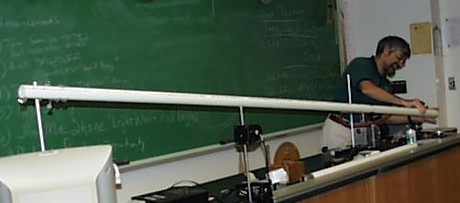 |
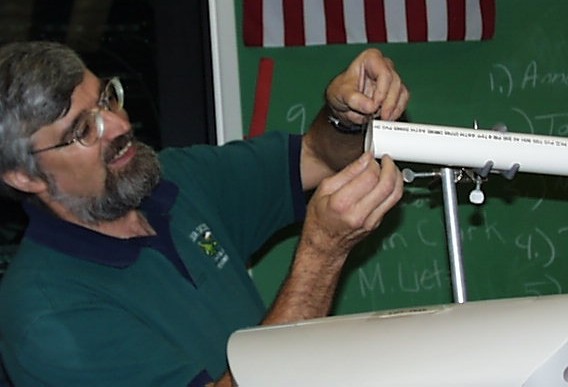 |
| Paul Waechtler told us how he sets up a Pasco track with a force sensor and a motion detector. A cart has a collision with the force sensor and the area under the force vs. time graph is used to find the impulse and Du is obtained from the motion detector data. This is a good way of showing that impulse equals change of momentum. Paul also uses two motion detectors, one placed above the other, to observe a two-cart collision. One cart has a reflector mounted at a distance above the cart, in line with the upper motion detector. This enables the students to see the graphs of velocity vs. time for both carts before, during and after the collision. | 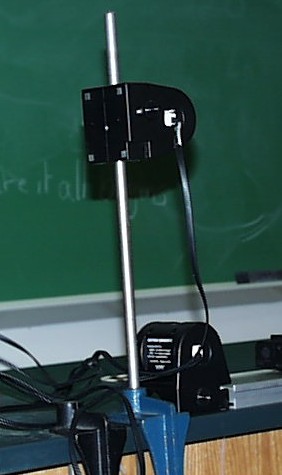 |
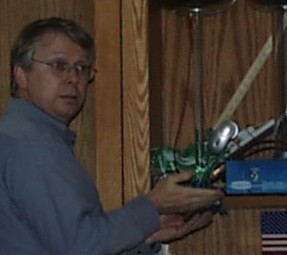 |
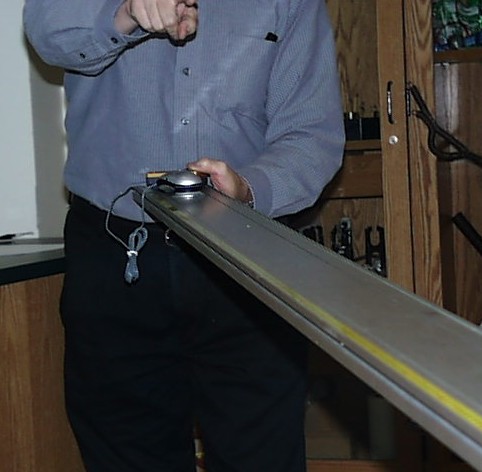 |
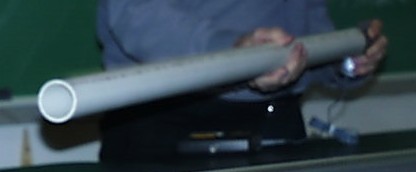 |
| John Seim (student teaching at New Trier) clamped a meter stick in a horizontal position and hung a 500-gram mass from a piece of string at the free end of the stick. John asks his students to predict what will happen when the mass is lifted to the level of the meter stick and then dropped. John did this and we saw that the string did not break. But when he repeated the procedure with the string located much closer to the clamped end the string did break. John gave us a brief explanation in terms of impulse; the force applied to the string at the end where the stick has room to bend acted over a longer time interval, so the average force was lower. | 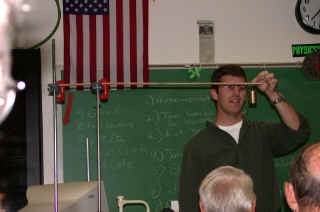 |
| Pete Insley (Columbia College) showed us the latest work he had done on the inverted pendulum – a thin rod mounted on a pin attached to a function generator. Instead of using soda straws he drilled small holes in small dowel rods. These rods don’t bounce up and down on the pin as the soda straws do. Pete found that the rod would oscillate in a vertical position at about 60 Hz and higher. He studied the length dependence and found that longer rods are not stable at lower frequencies and that at higher frequencies the oscillations are stable but at reduced amplitude. Pete obtained stable oscillations for a short rod from 25 Hz up to about 90 Hz. He offered a qualitative explanation in terms of torques and referred us again to the article in the September Physics Teacher. (Pete and others are skeptical about the authors’ explanation. What do you think?) | 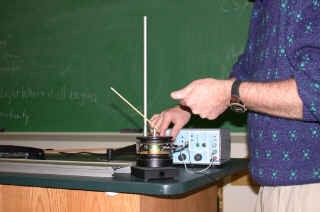 |
| Paul Dolan (Northeastern Illinois University) connected two plastic Pasco carts with springs to set up a coupled oscillator system. He used a variety of springs in different configurations and showed us what happens when friction is significant (the carts have adjustable friction pads). He has only done qualitative work with this setup, so we look forward to hearing more about it. Then in the spirit of Halloween, Paul used a vacuum food saver (available in grocery stores or from Educational Innovations?) to expand Ghost Marshmallows and Cocoa Bats. | 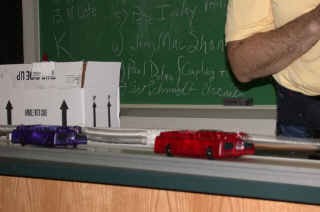 |
| Art Schmidt (Northwestern University) showed us an Energy Ball (Safari Ltd or Arbor Scientific, $3.25), a ping-pong sized ball with two metal terminals. If one touches both terminals this completes a circuit (FET?) and a bulb inside the ball lights. Art set up some “human circuits” by having us join hands to make series and parallel connections, and then a neat demonstration of a two switch (logical OR) circuit, in which the two human switches turned the ball on and off by simulating the “up” and “down” positions. | 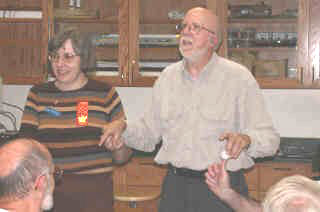 |
Fred Hartline (Argonne National Laboratory) gave out packets for high school teachers describing an exhibit design contest. Students must design and build a prototype educational exhibit related to the science behind the Advanced Proton Source.
John Milton (DePaul University) brought Vernier’s force plate that connects to their LabPro unit. It measures force in two Newton ranges and in pounds. He had taken it on an elevator and showed us the force vs. time graph. We could see the record of the force on the plate change abruptly to a slightly higher nearly constant value for a little less than two seconds while the elevator accelerated and then return to the value of his weight as the elevator rose with constant velocity. We brainstormed ideas for other applications – bouncing balls, elastic and inelastic collisions, amusement park rides. John wants to take it on a Ferris wheel or a roller coaster.
Jim Clark (Northern Illinois University) talked about the ripple tank analogy of the double slit experiment. He contrasted Feynman’s “classical” treatment of refractive index in the Feynman Lectures with the quantum mechanics treatment in Feynman’s QED and raised a question about the temperature dependence of the refractive index: what does this mean for charges in a “vacuum”?
Martha Lietz (Niles West High School) told us she requires her
students to work in pencil and gave us “Physics is Phun” pencils she obtained
from Atlas Pen and Pencil. (You can find them on Google.)
Ann Brandon (Joliet West High School) brought the support rods
for the pressure demonstration giveaway from our Joliet meeting. These
pieces were not ready at that meeting, so now the apparatus is complete.
It works very well, demonstrating pressure as force per unit area – with
a bang!
| Tom Senior passed out Inertia Club cards for students (an idea from John Lewis) and showed us how to demonstrate inertia by flipping a card out from under a coin balanced on your finger. The best coin, he told us, is a Japanese yen. Then he brought out the giveaway. This was an updated version (assembly required) of the PVC stadium horn we had seen at earlier meetings. This one has an adjustable “slide” section so the frequency can be varied. Several of us (e.g., John Spokas) couldn’t wait and the noisemaking began. Thanks to our New Trier colleagues for a worthwhile evening of physics phun. | 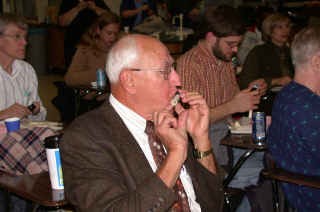 |
Photos by John Milton and Earl Zwicker
